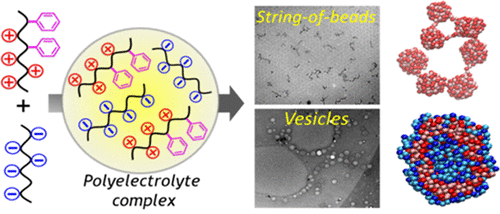当前位置:
X-MOL 学术
›
Macromolecules
›
论文详情
Our official English website, www.x-mol.net, welcomes your
feedback! (Note: you will need to create a separate account there.)
Unusual Nanostructured Morphologies Enabled by Interpolyelectrolyte Complexation of Polyions Bearing Incompatible Nonionic Segments
Macromolecules ( IF 5.1 ) Pub Date : 2020-11-30 , DOI: 10.1021/acs.macromol.0c02230 Biswajit Saha 1 , Yulia D. Gordievskaya 2, 3 , Priyadarsi De 1 , Elena Yu. Kramarenko 2, 3
Macromolecules ( IF 5.1 ) Pub Date : 2020-11-30 , DOI: 10.1021/acs.macromol.0c02230 Biswajit Saha 1 , Yulia D. Gordievskaya 2, 3 , Priyadarsi De 1 , Elena Yu. Kramarenko 2, 3
Affiliation

|
The nanostructures of polyelectrolyte complexes (PECs) fabricated from a series of rationally designed oppositely charged amphiphilic random copolymers with variable comonomer compositions were studied experimentally in 50:50 (v/v) methanol–H2O mixtures through morphological investigations. Both polycationic [poly(alanine methacryloyloxyethyl ester-co-styrene), P1–P4] and polyanionic [poly(acrylic acid-co-methyl acrylate), P1′–P4′] electrolytes were synthesized via reversible addition–fragmentation chain-transfer (RAFT) copolymerization while maintaining the mole fractions of charge-bearing groups within the range of 50–90%. Unlike polyanions, polycations showed well pronounced pH-responsive behavior owing to pH-induced protonation/deprotonation phenomena of pendant quaternary ammonium groups. On account of this fact, PEC formation with concomitant microphase separation was realized at pH 5.0 when all obtained compositions of both polycations and polyanions were totally soluble. Fine tuning of alanine-derived cationic and anionic acrylic acid compositions confers uncommon morphologies revealed by electron microscopic observations. Intriguingly, a “string-of-beads” like morphology was observed for PECs prepared with 50 and 60% charged ratios, whereas spherical micelles and vesicles were formed in the case of 70 and 90% ratios, respectively, attributed to the strength of electrostatic interaction and incompatibility of nonionic segments. These fascinating morphologies were further corroborated by computer simulations of two oppositely charged chains within a coarse-grained approach. A diagram of PEC morphologies was constructed depending on the hydrophobic/hydrophilic composition of polyions, fraction of ion-containing groups, and the strength of electrostatic interactions. Observation of these unique morphologies from a single pair of a polyelectrolyte system is scarcely reported in the literature.
中文翻译:

异常的纳米结构形态由不相容的非离子链段的聚离子间的聚电解质络合引起
在50:50(v / v)甲醇-H 2 O混合物中,通过形态学研究,对由一系列合理设计的带相反电荷的两亲性无规共聚物和可变共聚单体组成的聚电解质复合物(PEC)的纳米结构进行了实验研究。聚阳离子[聚(丙氨酸-甲基-丙烯酰氧基乙基酯-共苯乙烯),P1 - P4 ]和聚阴离子[聚(丙烯酸-丙烯酸-共-丙烯酸甲酯),P1' - P4']电解质是通过可逆加成-断裂链转移(RAFT)共聚反应合成的,同时将带电荷基团的摩尔分数保持在50-90%的范围内。与聚阴离子不同,由于阳离子引起的季铵基侧基的质子化/去质子化现象,聚阳离子表现出明显的pH响应行为。由于这个事实,当所有获得的聚阳离子和聚阴离子的组合物都完全可溶时,在pH 5.0下实现了伴随微相分离的PEC形成。丙氨酸衍生的阳离子和阴离子丙烯酸组成的微调赋予电子显微镜观察所揭示的罕见形态。有趣的是,对于荷电率为50%和60%的PEC,观察到了“串珠状”的形态,球形胶束和囊泡分别以70%和90%的比例形成,这归因于静电相互作用的强度和非离子链段的不相容性。这些令人着迷的形态在粗粒度方法中通过两条相反电荷链的计算机模拟得到了进一步证实。根据聚离子的疏水/亲水组成,含离子基团的比例以及静电相互作用的强度,构建了PEC形态图。从文献中几乎没有报道过从一对聚电解质系统中观察到这些独特的形态。这些令人着迷的形态在粗粒度方法中通过两条相反电荷链的计算机模拟得到了进一步证实。根据聚离子的疏水/亲水成分,含离子基团的比例以及静电相互作用的强度,构建了PEC形态图。从文献中几乎没有报道过从一对聚电解质系统中观察到这些独特的形态。这些令人着迷的形态在粗粒度方法中通过两条相反电荷链的计算机模拟得到了进一步证实。根据聚离子的疏水/亲水成分,含离子基团的比例以及静电相互作用的强度,构建了PEC形态图。从文献中几乎没有报道过从一对聚电解质系统中观察到这些独特的形态。
更新日期:2020-12-22
中文翻译:

异常的纳米结构形态由不相容的非离子链段的聚离子间的聚电解质络合引起
在50:50(v / v)甲醇-H 2 O混合物中,通过形态学研究,对由一系列合理设计的带相反电荷的两亲性无规共聚物和可变共聚单体组成的聚电解质复合物(PEC)的纳米结构进行了实验研究。聚阳离子[聚(丙氨酸-甲基-丙烯酰氧基乙基酯-共苯乙烯),P1 - P4 ]和聚阴离子[聚(丙烯酸-丙烯酸-共-丙烯酸甲酯),P1' - P4']电解质是通过可逆加成-断裂链转移(RAFT)共聚反应合成的,同时将带电荷基团的摩尔分数保持在50-90%的范围内。与聚阴离子不同,由于阳离子引起的季铵基侧基的质子化/去质子化现象,聚阳离子表现出明显的pH响应行为。由于这个事实,当所有获得的聚阳离子和聚阴离子的组合物都完全可溶时,在pH 5.0下实现了伴随微相分离的PEC形成。丙氨酸衍生的阳离子和阴离子丙烯酸组成的微调赋予电子显微镜观察所揭示的罕见形态。有趣的是,对于荷电率为50%和60%的PEC,观察到了“串珠状”的形态,球形胶束和囊泡分别以70%和90%的比例形成,这归因于静电相互作用的强度和非离子链段的不相容性。这些令人着迷的形态在粗粒度方法中通过两条相反电荷链的计算机模拟得到了进一步证实。根据聚离子的疏水/亲水组成,含离子基团的比例以及静电相互作用的强度,构建了PEC形态图。从文献中几乎没有报道过从一对聚电解质系统中观察到这些独特的形态。这些令人着迷的形态在粗粒度方法中通过两条相反电荷链的计算机模拟得到了进一步证实。根据聚离子的疏水/亲水成分,含离子基团的比例以及静电相互作用的强度,构建了PEC形态图。从文献中几乎没有报道过从一对聚电解质系统中观察到这些独特的形态。这些令人着迷的形态在粗粒度方法中通过两条相反电荷链的计算机模拟得到了进一步证实。根据聚离子的疏水/亲水成分,含离子基团的比例以及静电相互作用的强度,构建了PEC形态图。从文献中几乎没有报道过从一对聚电解质系统中观察到这些独特的形态。











































 京公网安备 11010802027423号
京公网安备 11010802027423号